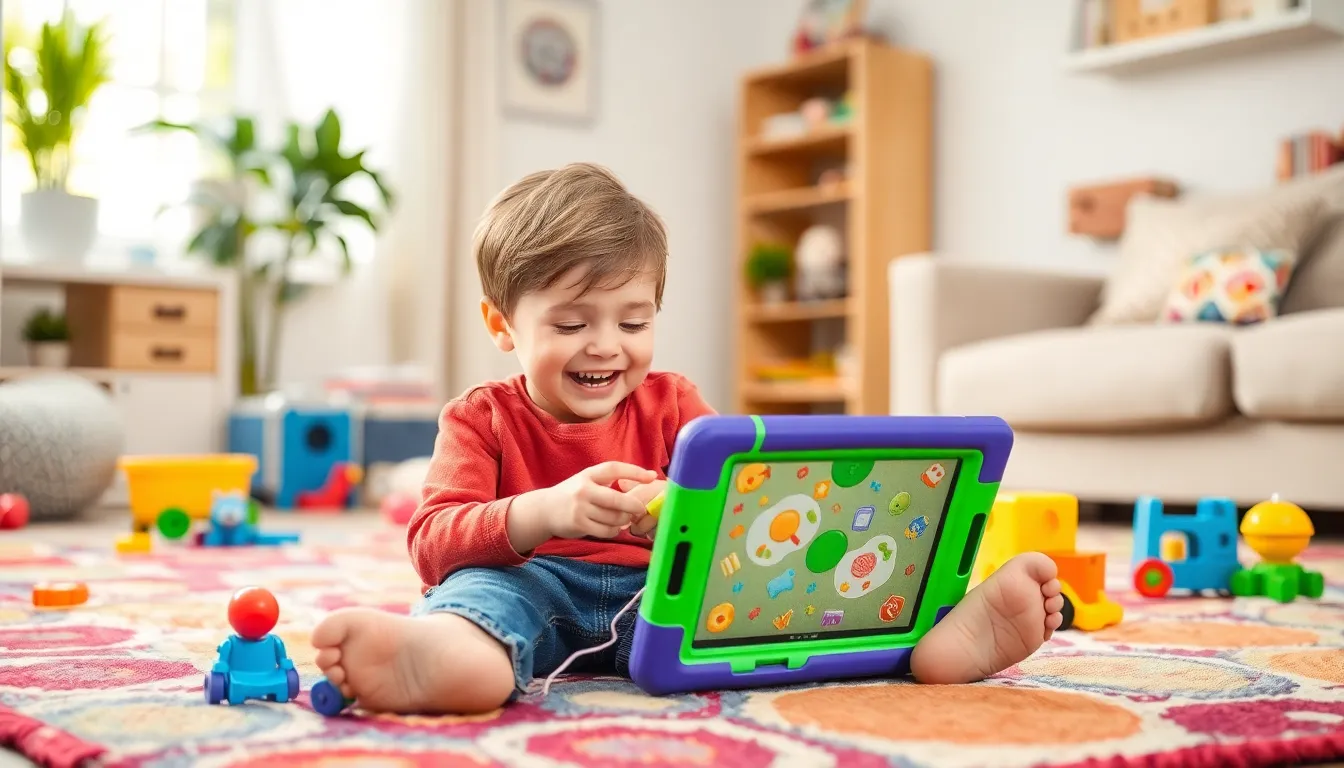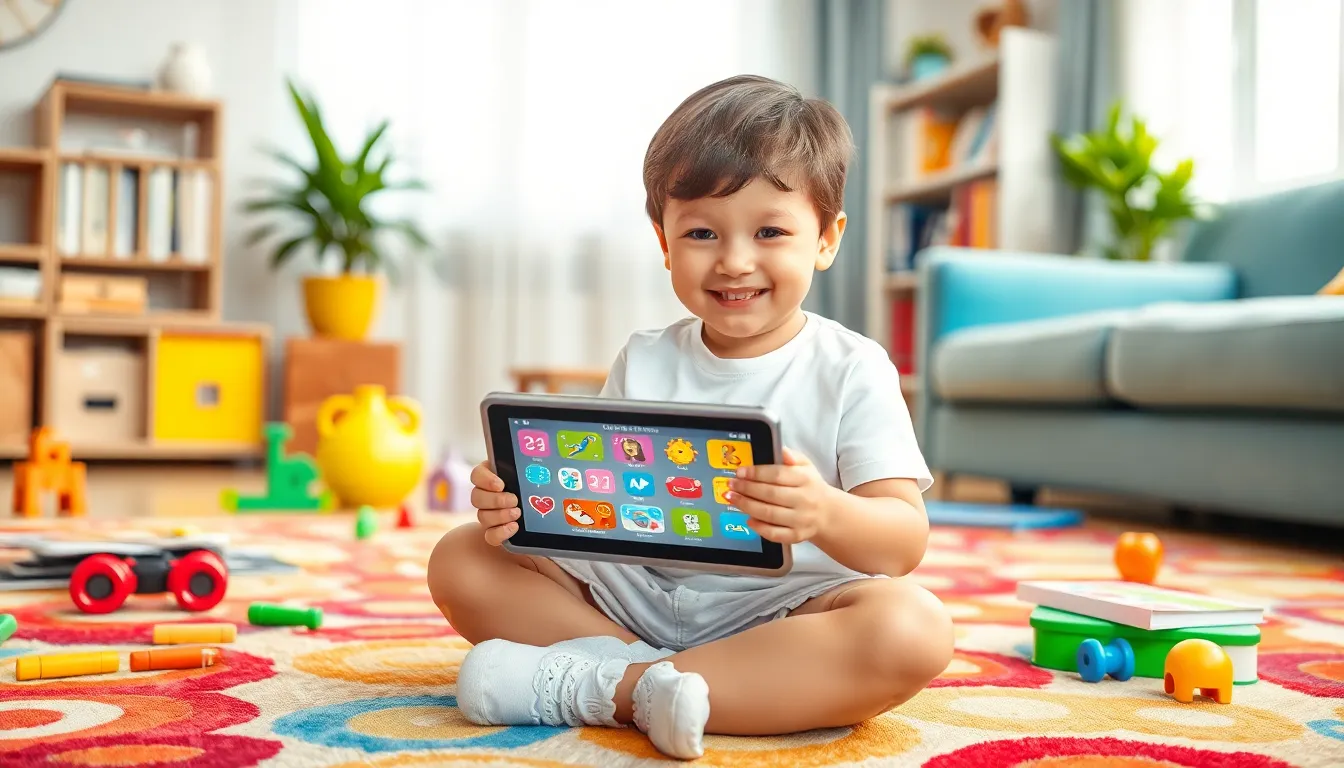In a world where kids are glued to screens faster than a squirrel on a nut, finding the right tablet can feel like searching for a needle in a haystack. Parents want devices that entertain, educate, and maybe even keep their little ones from turning into couch potatoes. Enter the realm of kids’ tablets, where fun meets functionality, and tantrums can be avoided with the right tech.
Table of Contents
ToggleOverview of Kids Tablets
Kids tablets offer an engaging balance between educational and entertaining experiences. Many models include interactive learning apps, games, and access to e-books, promoting both cognitive development and creativity. Battery life commonly ranges from 6 to 12 hours, making them suitable for long travel times or extended play sessions.
Parental controls are a critical aspect of kids’ tablets, allowing guardians to restrict content and manage usage time. Safety features often include web filtering and app approval systems, ensuring children explore age-appropriate material. Most devices provide customizable profiles for multiple children, creating a personalized user experience.
Screen size and resolution vary among options, typically falling between 7 to 10 inches, catering to different preferences and needs. Connectivity options such as Wi-Fi and Bluetooth enable children to access educational resources and entertainment on demand. Many models come equipped with durable cases designed to withstand drops and spills, addressing common concerns associated with young users.
Storage capabilities also differ, with internal memory ranging from 16 to 128 GB. Some tablets support expandable storage, allowing parents to manage apps and media effectively. Offering both ruggedness and functionality, kids’ tablets can easily incorporate tools for online learning and creativity, fostering a productive environment.
Overall, kids tablets encourage exploration while providing controlled environments, securing peace of mind for parents and enriching experiences for children.
Key Features to Look For

Selecting the right kids’ tablet requires attention to several key features. Understanding these characteristics ensures the device meets educational and entertainment needs.
Screen Size and Resolution
Screen sizes typically range from 7 to 10 inches, which suits children’s hands for comfortable handling. Larger screens enhance visibility for streaming videos or reading e-books. Resolution matters for clarity; higher resolutions provide sharper images. Many tablets boast HD displays, improving the overall viewing experience. Parents should seek models with responsive touch technology, allowing kids to interact without frustration.
Battery Life
Battery life remains crucial for uninterrupted usage, with ranges often between 6 to 12 hours. Longer battery life proves beneficial for travel or extended play sessions. Models with efficient power management support activities throughout the day without constant recharging. Parents appreciate tablets that charge quickly, enabling fast turnaround times for on-the-go entertainment. Kids can enjoy games and educational apps without interruption, which helps maintain engagement.
Durability and Build Quality
Durability should be a top consideration for parents. Tablets designed for kids often feature rugged cases that withstand drops and spills. A solid build quality helps prevent damage during everyday usage. Many models utilize reinforced materials to enhance longevity. Parents benefit from knowing devices can endure the rough handling common among younger users, providing peace of mind.
Top Kids Tablets on the Market
Many options exist to meet children’s needs in entertainment and learning. Each tablet varies in features, ensuring parents can find the best fit for their kids.
Tablet A Review
Tablet A excels in performance with its vibrant 8-inch display and sturdy construction. Equipped with 32 GB of internal storage, it allows plenty of space for apps, games, and e-books. Battery life reaches up to 10 hours, providing ample time for uninterrupted use. Pre-installed educational apps enhance learning, while robust parental controls let guardians manage screen time easily. Its interactive features keep kids engaged and foster creativity.
Tablet B Review
Tablet B stands out due to its large 10-inch display and high-resolution graphics, offering a superior visual experience. Featuring a rugged design, this tablet withstands rough handling from young users. Its 64 GB of storage accommodates a variety of apps and multimedia content. With 12 hours of battery life, kids enjoy extended play without frequent interruptions. Built-in safety features help ensure kids access age-appropriate material, providing peace of mind for caregivers.
Tablet C Review
Tablet C is known for its lightweight build, making it easy for kids to handle. Its 7-inch display strikes a balance between portability and functionality. This tablet offers 16 GB of internal storage, expandable via microSD for additional content. Parents appreciate its 8-hour battery life, allowing for long outings or travel. Remote parental controls make monitoring usage straightforward, promoting a healthy balance between play and educational activities.
Comparing Kids Tablets
Selecting the right kids’ tablet involves evaluating price and features. Understanding the differences helps parents make informed decisions.
Price Comparison
Price points for kids’ tablets range significantly. Tablet A costs approximately $99, making it an affordable choice for families. Tablet B, with added features, retails for around $199. Tablet C offers a budget-friendly option at about $79, appealing to cost-conscious parents. As prices fluctuate, exploring sales and promotions may provide opportunities for better deals on these devices.
Feature Comparison
Features greatly influence tablet usability. Tablet A includes a vibrant 8-inch display, enhancing visual engagement for kids. With a 10-hour battery life, it supports extended use without frequent recharging. Tablet B excels with a large 10-inch high-resolution display, ensuring quality graphics for gaming and educational content. Its robust design enhances durability, ideal for active children. Meanwhile, Tablet C, while lightweight and smaller at 7 inches, still delivers essential features like remote parental controls and expandable storage, catering to young users’ needs. Each tablet presents unique capabilities suited to varying preferences.
Conclusion
Choosing the right tablet for kids can significantly impact their learning and entertainment experience. With various options available parents can find devices that cater to their children’s unique needs while ensuring safety and durability.
By considering factors like screen size battery life and parental controls parents can make informed decisions that support their children’s growth. Each reviewed tablet presents distinct advantages making it easier to match a device with a child’s preferences and requirements.
Investing in a quality kids’ tablet not only keeps children engaged but also fosters a love for learning in a fun and interactive way.




